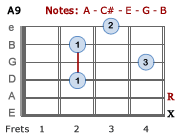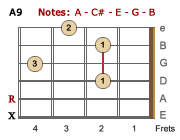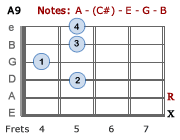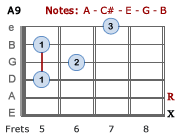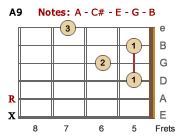A9 guitar chords
A - C# - E - G - BA9 chords typically consists of the 1st, 3rd, 5th, b7th, and 9th notes of the A Major Scale.
- Construction: root, major third, perfect fifth, minor seventh, and ninth.
- A Major Scale: A - B - C# - D - E - F# - G# - A - B.
- We add the extra notes at the end of the scale as ninth chords extend beyond an octave
- Chord: A9
- Formula: 1 - 3 - 5 - ♭7 - 9
- Notes: A - C# - E - G - B
A9 - A ninth (1-3-5-b7-9)
Spelling: 1st(A), 3rd(C#), 5th(E), b7th(G), 9th(B)
Chart Legend
Numbered Circles: number inside circle indicates which finger to useX: Don't play string
White Numbered Circles: Optional Notes
X on string with optional note: if you omit the note, don't play string
Unmarked strings: Play open
Barre Line: One finger holds down multiple strings
R: Root Note
TAB: Numbers represent frets - not finger positions
Blank Strings: Do not Play
0: play string open
↓ A9 Guitar Chords
Notes
- This chord is a dominant 9th chord which is a dominant 7th chord with an added 9th. It is an extended chord which includes the dominant 7th in its structure.
- If a chord with a symbol 9 is not preceded by the words major or maj, i.e., A9 as opposed to Amaj9, the 7th is always a dominant 7th (♭7).
- 9th chords imply the presence of the preceding 1st, 3rd, 5th, ♭7th, before the added 9th.
- In the 2nd position chord, the 3rd is omitted... this is a particular voicing of the 9th chord where the third is omitted, and the 9th is played an octave lower... this could also be classed as a 7th suspended 2nd chord, in this case A7sus2. The chord formula is 1-2-5-♭7 = A-B-E-G (notes in the second position).
- Standard keys using the A ninth chord: D/Bm.
Bm is the relative minor of D major which means both scales share the same notes. A9 (A - C# - E - G - B) utilizes notes belonging to the D Major & Bm Scale... D-E-F#-G-A-B-C#.
Interesting facts about A9 chords
- Often used as dominant chords, meaning they create tension that wants to resolve to a consonant chord, usually the tonic (I) or a related chord like A major.
- The ninth (B) is the most distinctive note in the chord. It adds a jazzy and colorful sound to the chord, making it more interesting than a standard dominant seventh (A7) chord.
- Can be played in different inversions, which means that the order of the notes is rearranged. This can create different chord voicings and textures.
- Can be used as substitutes for A7 chords in various musical contexts. This substitution can add more harmonic interest to a progression.
- Frequently used in jazz and funk music due to their rich and sophisticated sound. They are often used in extended jazz chord progressions.
- The ninth (B) often resolves up to the third (C#) in chord progressions. This movement creates smooth voice leading and a sense of resolution.
- In funk and R&B music, A9 chords are often played with rhythmic variations, such as staccato or syncopated strumming patterns, to create a groovy feel.
- They can be part of interesting chord progressions. For example, you might find them in sequences like A9 - D9 - Gmaj7 - Cmaj7, which can create a jazzy and sophisticated vibe.
- A9 is just one example of an extended chord. Extended chords (7ths, 9ths, 11ths, 13ths) are commonly used in jazz and other genres to add complexity and color to chord progressions.
